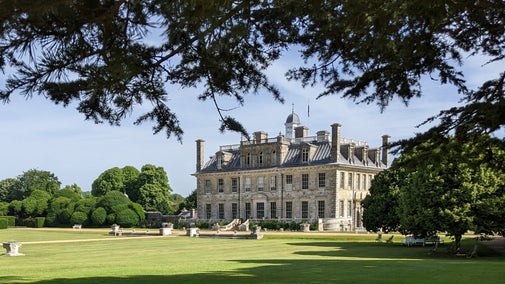
Donate
Everyone needs nature, now more than ever. Donate today and you could help people and nature to thrive at the places we care for.

The Kitchen Garden at Kingston Lacy was once renowned for its elegance and horticultural opulence. It was built in 1876 at a cost of £2,740 (about £180,000 today), and cultivated the best fruit, vegetables and flowers for use in the house. Inspired by its former glory, we’re restoring this once-thriving part of the garden.
The Kitchen Garden at Kingston Lacy reached peak production in the late 19th and early 20th centuries. It showcased the latest in garden technology, with heated glasshouses where the family grew fruits, vegetables and herbs alongside exotic flowers.
By the 1960s the Kitchen Garden had fallen into decline. When the National Trust acquired Kingston Lacy in 1982, it was completely overgrown. Some of the original features, such as the ornamental show houses, had been lost and others were beyond repair.
We’ve been working hard to bring Walter Bankes’ dream Victorian Kitchen Garden back to life, restoring the flower garden to its original design and providing a sense of how the remaining buildings would have been used.
Historic path networks have been reinstated, thatched summerhouses recreated and borders replanted to create a colourful and vibrant space.
The vinery, part of a U-shaped range of glasshouses originally constructed in 1879, had fallen into disrepair and been taken down. We rebuilt it with a new timber frame, using fixtures and fittings from the original glasshouse.
It now houses some of the historic vines alongside citrus fruit and fan-trained peaches.
Melons were just one of the exotic fruits grown at Kingston Lacy. In 2022 the gardeners grew melons in the melon house for the first time in half a century. They used methods unchanged since the Victorian era to grow an old heritage variety of melon, Blenheim Orange, which was a favourite of Victorian gardeners.
In the growing seasons of 1908-09 the gardeners planted 71 varieties of apple tree, 52 varieties of pear and 19 varieties of plum. In 2022 a new orchard was planted around a 100m long arch that will be covered with roses as well as espaliered fruit trees, using historic varieties.
The Kitchen Garden was much loved by the Bankes children, who visited to beg an apple or pear from the head gardener. Now, there's a new play area for children, and a kiosk serving hot and cold drinks and light snacks.
The ornate iron gates were made by the same West Midlands ironworks firm that manufactured anchors for the Titanic. The gates have been carefully restored using traditional craftsmanship, and repainted the same grey-green colour originally chosen by Henrietta Bankes in 1912.

The Kitchen Garden is now supplying produce to Kingston Lacy’s Stables café: butternut squash and pumpkins went into tagine and soups, apples into the famed Dorset Apple cake and salads and herbs grown throughout the winter were used for garnish.
The garden team plans to increase the produce supplied to the café, and any surplus will be on sale in the Kitchen Garden. Look out for more home-grown produce over time.
It’s thanks to generous donations that we’re able to bring the garden back to life at Kingston Lacy. As a conservation charity, we rely on donations to fund the work we do for future generations.

Everyone needs nature, now more than ever. Donate today and you could help people and nature to thrive at the places we care for.
Relax and wander the gardens to enjoy seasonal interest at any time of year, with plenty of space for children to run, skip and play, and spaces to stop along the way.

Find out more about the Bankes family home. Discover art treasures and look at how a large home was used by the family and their visitors who came to stay.

Learn about some of the prized items that are housed at Kingston Lacy, several of which feature in the National Trust's book 125 Treasures.

A vision from Venice nestled in a pocket of Dorset. Read about Kingston Lacy’s most influential owner who made it the important place you see today.

Groups of visitors are warmly welcomed by the National Trust at Kingston Lacy. Find out more about booking your tickets and the benefits you’ll get.

Conservation work both indoors and out is a vital part of what the National Trust does at Kingston Lacy. Discover more about our latest initiatives.

There are numerous ways that you can volunteer with the National Trust at Kingston Lacy. Find out how to join our team.
